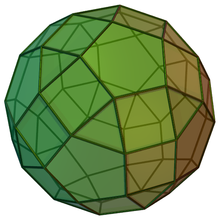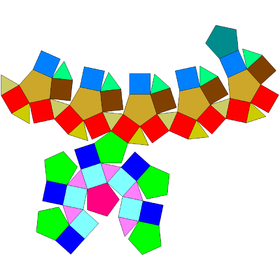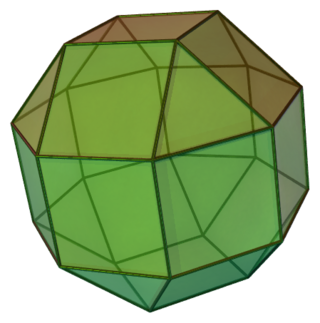
In geometry, a Johnson solid is a strictly convex polyhedron each face of which is a regular polygon. There is no requirement that each face must be the same polygon, or that the same polygons join around each vertex. An example of a Johnson solid is the square-based pyramid with equilateral sides ; it has 1 square face and 4 triangular faces. Some authors require that the solid not be uniform before they refer to it as a "Johnson solid".

In geometry, the rhombicosidodecahedron is an Archimedean solid, one of thirteen convex isogonal nonprismatic solids constructed of two or more types of regular polygon faces.

In geometry, a truncated icosidodecahedron, rhombitruncated icosidodecahedron, great rhombicosidodecahedron, omnitruncated dodecahedron or omnitruncated icosahedron is an Archimedean solid, one of thirteen convex, isogonal, non-prismatic solids constructed by two or more types of regular polygon faces.

In geometry, the triangular cupola is the cupola with hexagon as its base and triangle as its top. If the edges are equal in length, the triangular cupola is the Johnson solid. It can be seen as half a cuboctahedron. Many polyhedrons can be constructed involving the attachment of the base of a triangular cupola.

In geometry, the square cupola the cupola with octagonal base. In the case of edges are equal in length, it is the Johnson solid, a convex polyhedron with faces are regular. It can be considered as half of the rhombicuboctahedron. It can be used to construct many polyhedrons, particularly in other Johnson solids.

In geometry, the gyroelongated square bicupola is the Johnson solid constructed by attaching two square cupolae on each base of octagonal antiprism. It has the property of chirality.

In geometry, the pentagonal cupola is one of the Johnson solids. It can be obtained as a slice of the rhombicosidodecahedron. The pentagonal cupola consists of 5 equilateral triangles, 5 squares, 1 pentagon, and 1 decagon.

In geometry, the diminished rhombicosidodecahedron is one of the Johnson solids. It can be constructed as a rhombicosidodecahedron with one pentagonal cupola removed.

In geometry, the metabidiminished rhombicosidodecahedron is one of the Johnson solids.

In geometry, the trigyrate rhombicosidodecahedron is one of the Johnson solids. It contains 20 triangles, 30 squares and 12 pentagons. It is also a canonical polyhedron.

In geometry, the pentagonal gyrobicupola is one of the Johnson solids. Like the pentagonal orthobicupola, it can be obtained by joining two pentagonal cupolae along their bases. The difference is that in this solid, the two halves are rotated 36 degrees with respect to one another.

In geometry, the elongated pentagonal gyrobicupola is one of the Johnson solids. As the name suggests, it can be constructed by elongating a pentagonal gyrobicupola by inserting a decagonal prism between its congruent halves. Rotating one of the pentagonal cupolae through 36 degrees before inserting the prism yields an elongated pentagonal orthobicupola.

In geometry, the parabigyrate rhombicosidodecahedron is one of the Johnson solids. It can be constructed as a rhombicosidodecahedron with two opposing pentagonal cupolae rotated through 36 degrees. It is also a canonical polyhedron.
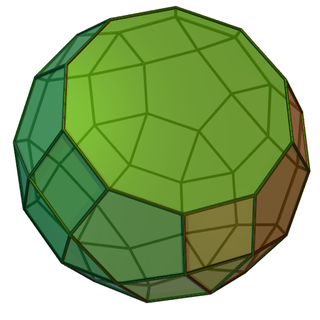
In geometry, the metagyrate diminished rhombicosidodecahedron is one of the Johnson solids. It can be constructed as a rhombicosidodecahedron with one pentagonal cupola rotated through 36 degrees, and a non-opposing pentagonal cupola removed.

In geometry, the bigyrate diminished rhombicosidodecahedron is one of the Johnson solids. It can be constructed as a rhombicosidodecahedron with two pentagonal cupolae rotated through 36 degrees, and a third pentagonal cupola removed.
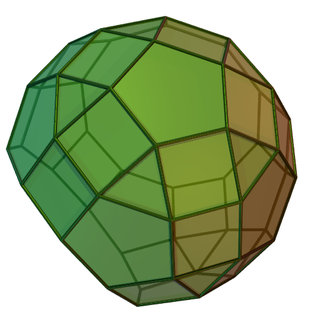
In geometry, the gyrate bidiminished rhombicosidodecahedron is one of the Johnson solids.
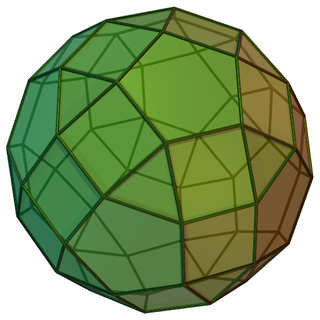
In geometry, the metabigyrate rhombicosidodecahedron is one of the Johnson solids. It can be constructed as a rhombicosidodecahedron with two non-opposing pentagonal cupolae rotated through 36 degrees. It is also a canonical polyhedron.
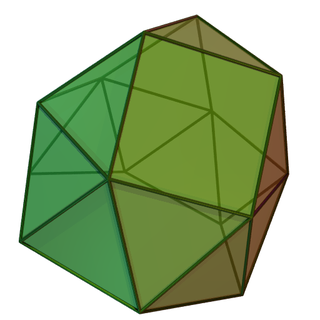
In geometry, the gyroelongated triangular cupola is one of the Johnson solids (J22). It can be constructed by attaching a hexagonal antiprism to the base of a triangular cupola (J3). This is called "gyroelongation", which means that an antiprism is joined to the base of a solid, or between the bases of more than one solid.

In geometry, the elongated triangular orthobicupola or cantellated triangular prism is a polyhedron constructed by attaching two regular triangular cupola into the base of a regular hexagonal prism. It is an example of Johnson solid.
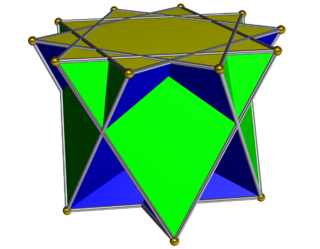
In geometry, the crossed pentagrammic cupola is one of the nonconvex Johnson solid isomorphs, being topologically identical to the convex pentagonal cupola. It can be obtained as a slice of the great rhombicosidodecahedron or quasirhombicosidodecahedron. As in all cupolae, the base polygon has twice as many edges and vertices as the top; in this case the base polygon is a decagram.
